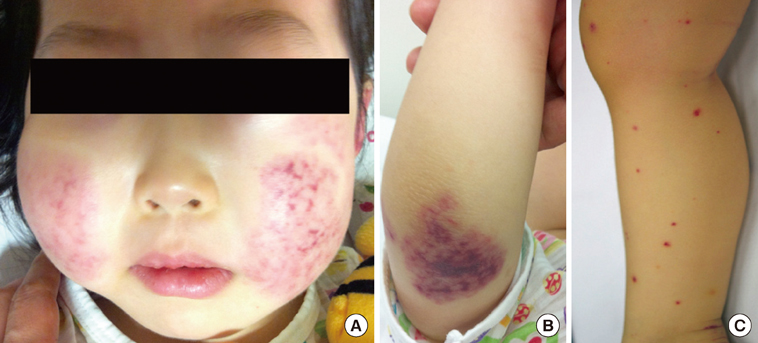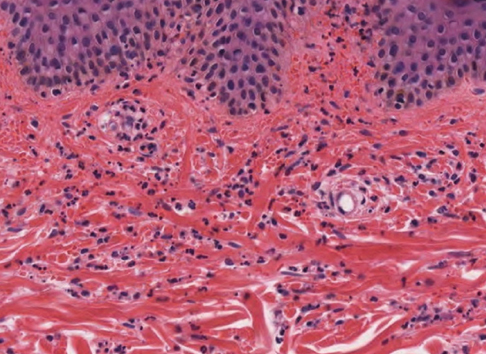J Korean Med Sci.
2012 Dec;27(12):1601-1603. 10.3346/jkms.2012.27.12.1601.
Leukocytoclastic Vasculitis Associated with Influenza A Virus Infection
- Affiliations
-
- 1Department of Dermatology, Yeungnam University College of Medicine, Daegu, Korea. dhshin@med.yu.ac.kr
- KMID: 2157991
- DOI: http://doi.org/10.3346/jkms.2012.27.12.1601
Abstract
- Leukocytoclastic vasculitis (LCV) usually presents palpable purpura characterized by inflammation of vessel walls and fragmentation of nuclei. Various conditions can cause LCV, and it can be induced by influenza A virus infection. We report a 2-yr-old Korean girl who presented palpable purpuric and hemorrhagic lesions with fever. She was diagnosed as LCV by skin biopsy, and influenza A virus was isolated from nasopharyngeal swab. She was treated with oseltamivir (Tamiflu(R)) and prednisolone with dramatic effect of vasculitis and fever.
MeSH Terms
-
Anti-Inflammatory Agents/therapeutic use
Antiviral Agents/therapeutic use
Child, Preschool
Female
Fever/etiology
Humans
Influenza A virus/*genetics/isolation & purification
Influenza, Human/*complications/drug therapy/virology
Nasopharynx/virology
Oseltamivir/therapeutic use
Prednisolone/therapeutic use
Reverse Transcriptase Polymerase Chain Reaction
Skin/pathology
Vasculitis, Leukocytoclastic, Cutaneous/*diagnosis/drug therapy/etiology
Anti-Inflammatory Agents
Antiviral Agents
Oseltamivir
Prednisolone
Figure
Reference
-
1. Lidar M, Lipschitz N, Langevitz P, Shoenfeld Y. The infectious etiology of vasculitis. Autoimmunity. 2009. 42:432–438.2. Silva ME, Cherry JD, Wilton RJ, Ghafouri NM, Bruckner DA, Miller MJ. Acute fever and petechial rash associated with influenza A virus infection. Clin Infect Dis. 1999. 29:453–454.3. Urso R, Bevilacqua N, Gentile M, Biagioli D, Lauria FN. Pandemic 2009 H1N1 virus infection associated with purpuric skin lesions : a case report. J Med Case Rep. 2011. 5:132.4. Guillevin L. Virus-induced systemic vasculitides: new therapeutic approaches. Clin Dev Immunol. 2004. 11:227–231.5. Clark NM, Lynch JP. Influenza: epidemiology, clinical features, therapy, and prevention. Semin Respir Crit Care Med. 2011. 32:373–392.6. Ison MG, Lee N. Influenza 2010-2011: lessons from the 2009 pandemic. Cleve Clin J Med. 2010. 77:812–820.7. Ryan-Poirier K. Influenza virus infection in children. Adv Pediatr Infect Dis. 1995. 10:125–156.8. Glezen WP. Feigin RD, Cherry JD, editors. Influenza viruses. Textbook of pediatric infectious diseases. 1998. 4th ed. Philadelphia: WB Saunders;2024–2041.9. Hope-Simpson RE, Higgins PG. A respiratory virus study in Great Britain: review and evaluation. Prog Med Virol. 1969. 11:354–407.
- Full Text Links
- Actions
-
Cited
- CITED
-
- Close
- Share
- Similar articles
-
- A Case of Leukocytoclastic Vasculitis Following COVID-19 Vaccination
- A Case of Leukocytoclastic Vasculitis after Influenza Vaccination
- A case of hypersensitivity vasculitis after influenza vaccination
- A Case of Leukocytoclastic Vasculitis after Influenza Vaccination
- Warfarin-induced Leukocytoclastic Vasculitis




